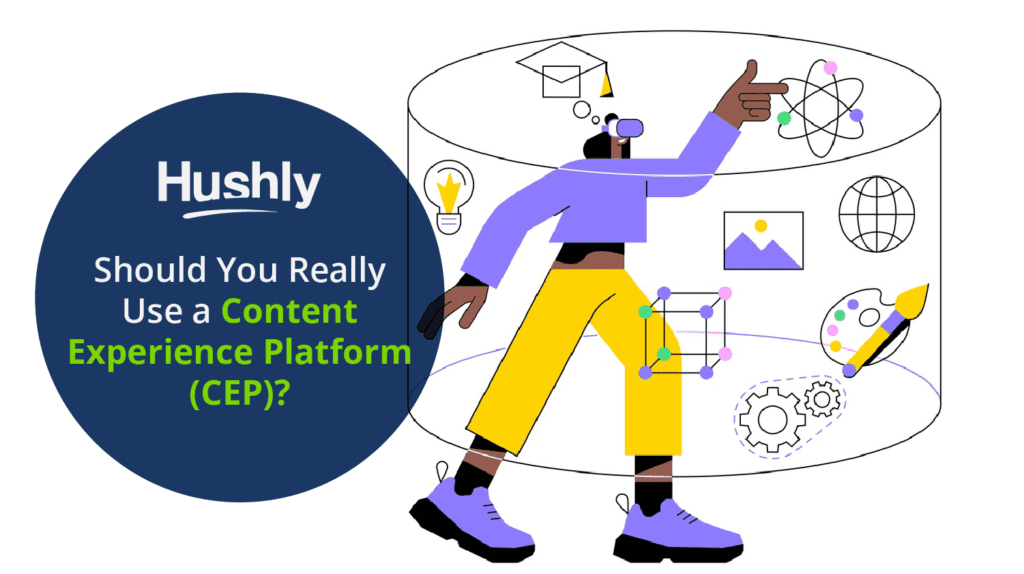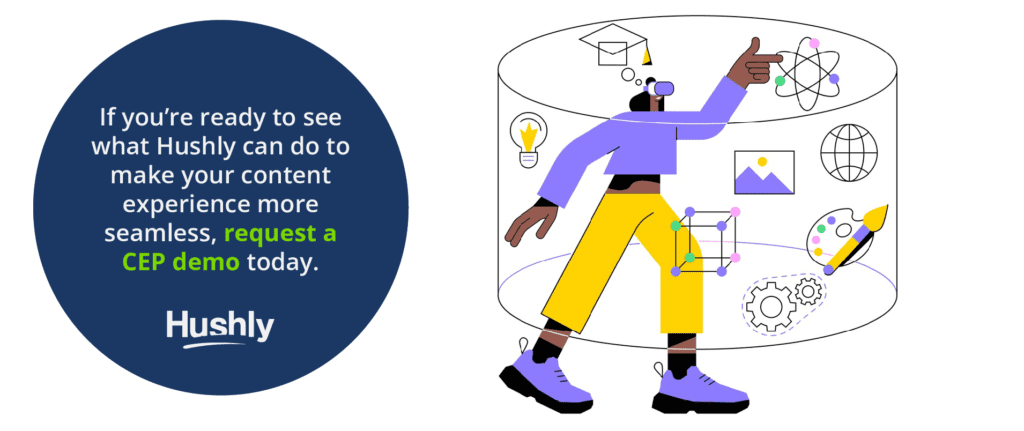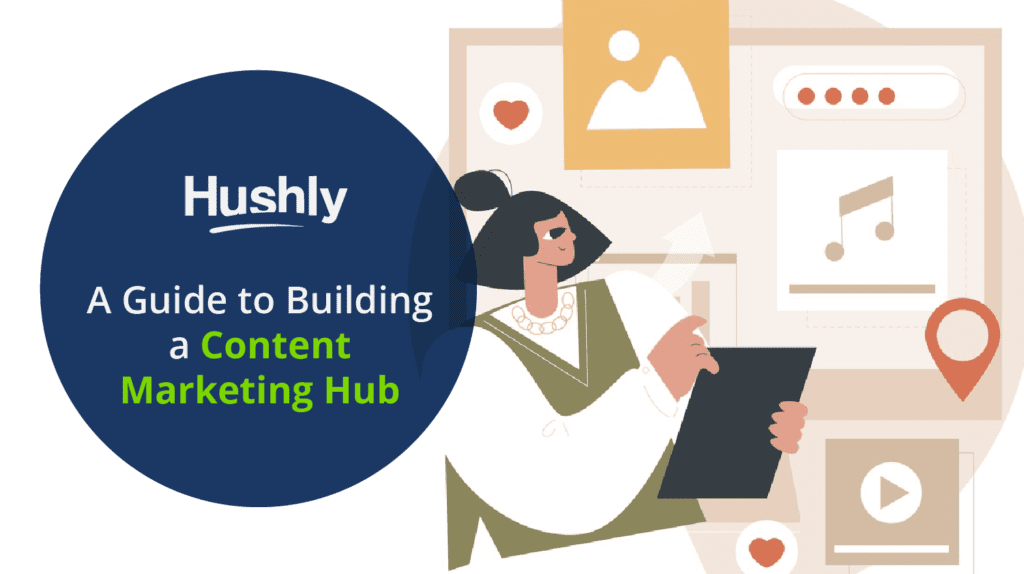Filters
Content Type
Topic
Should You Really Use a Content Experience Platform (CEP)?
Deciding on a strategy that will define your overall content experience is the easy part. The hard part is putting in the work to develop that experience across all forms of content.
If you’re thinking about implementing your own content experience strategy, then you’re probably wondering whether it would make more sense to employ a content experience platform to take on the job for you. There are plenty of ways to optimize on your own without a partner, yet few ways to match the data-driven analytics you’ll have access to with an automated platform.
We’ll lay out the case for using a content experience platform, but we’ll also explain the intricacies of the content experience, from what it is to how to start implementing one yourself, so you can make the best choice for your business.

What is the Content Experience?
The B2B content experience is the way all of your content relates to each other and forms a cohesive customer journey from landing page to checkout. A seamless and natural content experience is one in which the customer doesn’t have to try hard to find information about your product or why it should matter to them.
This is part of the reason why a great content experience should be a key part of any go-to-market strategy.
Your content experience should be an overarching voice or theme, which communicates a consistent message across all forms of content you produce. This includes content produced for every stage of the buyer journey. The main goal is steering prospects naturally through the content most likely to show value and convert them into buyers.
By focusing on and developing this goal through content production, you will naturally generate a content experience for customers. This experience should continue to develop over time as your products, customers, and market conditions evolve.
What is a Content Experience Platform?
A content experience platform (CEP) takes on the job of producing your content experience for you. Ideally, this includes everything from the way users first encounter your content, where they land on your website, what kind of content is recommended for them once they’re there, and generating data-driven customer insights.
5 Key Features to Look For in a Content Experience Platform
Here are five key features of a CEP:
1. Dynamic Web Design
Your website is the window through which your customers will look at your products. It’s where they’ll spend all their time engaging with your company online. Ideally, your website should be dynamically tailored to individual buyers.
Hushly’s platform allows clients to update their websites – including text, banners, calls to action, and more – to change in real time for individual customers.
2. Personalized Content
Once you’ve found your ideal buyers, it’s time to figure out what specific problems they may have and produce content tailored to their needs. This is the time to find your voice and stick to it in all forms of content.
Remember that there should be content for every step of the buyer journey. This includes the moment they find your landing page to the checkout process. The goal is a seamless transition from beginning to end.
3. Multiplatform Content
Customers today expect content in many formats and across many platforms. Some customers prefer written content, while many convert better with video content. You’ll need to mine your customers for data to figure out where they’re coming from and how they’d like to engage with your product.
It’s key that your content experience is cultivated across a wide range of content mediums. Blogs, social media posts, videos, audio, or podcasts each deserve special attention and a unique strategy that adheres to the overall content experience.
4. Digital Content Analytics
You’ll never have the perfect content experience because the ecosystem is constantly changing. There is a constant need to gather data on the performance of your strategy and update it on the fly.
You can try gathering data on your own, but it’s a complex process. It’s not always clear where to begin turning data into useful information. Instead, you should use a CEP like Hushly.
Hushly’s platform generates data from every stage of the customer experience, so you can analyze it from beginning to end. Hushly can give you insights like what content is resonating and where, engagement metrics, traffic sources, post-conversion analytics, and more.
5. Constant Optimization
However you’re getting your data, it’s important to use it to glean insight, so you can shape and optimize your content experience as needed.
The needs of your customers won’t stay the same, and your solutions to their new problems need to be flexible and responsive. A CEP should take data and optimization seriously to keep your strategy up to date.
Content Experience Platform vs. Content Marketing Software
A CEP is an automated service that takes on the task of optimizing your customer experience from beginning to end.
A CEP stands in contrast to typical content marketing software (CMS) which may focus narrowly on content creation, marketing, distribution, or content analytics. A CEP focuses more holistically on the way customers will be finding, consuming, and making decisions based on your content. It should also use data to generate insights that help you refine and update your content experience as market conditions change.
What Types of Content Can a CEP Manage?
Ultimately your content experience can be managed in a variety of ways. Depending on your customers and your product, a mixture of content mediums may be best, or you may find that your conversions rely on a single type of content. No matter your unique needs, a CEP should be able to manage all forms of content.
The idea behind the content experience is to push content that is relevant, valuable, and likely to drive engagement. A great CEP combines website customization with content personalization in service of the customer experience. Deciding what content works best for this is Hushly’s goal, and it’s the main reason we incorporate so much data and analytics into optimization.
The reality is that the best content is that which drives the most conversions, regardless of its medium, and your CEP should be capable of managing it.
A Content Experience Platform Can Save Time and Resources
The task of managing a content experience is unending.
There is the identification of buyers, content creation, deciding which content is most relevant to which buyers, personalization, multichannel outreach, and more. All must be carefully balanced and overseen to optimize performance.
Though it may be possible to manage on your own, hiring a content experience platform like Hushly could make your job a lot easier.
We’ll take on the time-consuming tasks for you. We know content marketing, and we’ve refined our system for years to take advantage of the massive amounts of data it generates. We use unparalleled customer insights to perfect the content experience, so you can focus on creating innovative solutions to customer problems.
If you’re ready to see what Hushly can do to make your content experience more seamless, request a CEP demo today.
The post Should You Really Use a Content Experience Platform (CEP)? appeared first on Hushly.



